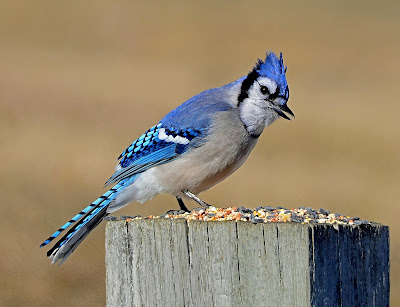 |
| Photo by Sue Pike A black swallowtail caterpillar with extended osmeterium — a bright orange defensive organ that releases foul-smelling chemicals to deter predators. |
Nature News
Baby black swallowtail butterflies are beautiful and common
by Sue Pike July 14 2016
We have a large patch of bronze fennel growing out back — this is unfortunate because it can be an aggressive invasive plant and is currently attempting to overrun my blueberry patch, but, on the other hand is good because it is home to a host of baby black swallowtail butterflies. These are one of our most common butterflies - adults are a gorgeous large black butterfly with two rows of yellow spots along the margins of the wings, and characteristic drooping “swallow” tails on the hindwings.
Black swallowtail egg photo by Sue Pike The fully grown caterpillars are just as attractive with colorful alternating stripes of greenish-white and black with six yellow dots embedded in each black stripe. I spotted a couple of these caterpillars gnawing on the foliage just last week. That same day a black swallowtail adult butterfly was fluttering around the garden. She circled the bronze fennel, periodically pausing at
the edges then darting away. While watching this I noticed that as she paused she would curl her abdomen toward the foliage - was laying eggs! These were tiny eggs, almost impossible to see unless you knew where to look. Little drops of gold on the ends of the lacey leaves of the fennel.
When they first hatch out of the egg black swallowtail caterpillars are black with a white stripe around the middle. At this stage they resemble a bird dropping, terrific camouflage for the young caterpillar. This kind of cryptic coloration isn’t unusual, other species of swallowtails use this approach to predator avoidance, as do some spiders, even frogs. As a side note - that white stripe is due to uric acid deposits that are thought to protect the caterpillars from a toxic chemical (furocoumarin) found in their diet. Members of the Umbelliferae family, like fennel, dill and carrots, all of which are host plants for black swallowtail caterpillars, produce furocoumarins as a defense against micro-organisms.
Depositing eggs
As they age, black swallowtail caterpillars change their defense strategy. Later instars take on the alternating stripes of green and white and yellow that help break up their profile, allowing them to hide in the delicate foliage of their host plants. Oils from their host plants black swallowtails make them taste bad. And if that isn’t enough, like the larvae of other types of swallowtails they have a defensive structure located behind their head called an osmeterium,
The osmeterium is usually hidden, when threatened this fleshy, orange, v-shaped organ sticks out and releases a foul odor that is distasteful to insect predators. While trying to take a picture of an extruded osmeterium I spent some time bothering one of my backyard swallowtail caterpillars. However, when it flailed its osmeterium at me, I didn’t smell a foul odor, I caught a whiff of something sweet and citrusy. Joe Ballenger, in his always fascinating blog “Ask an Entomologist” tackled the question of what the osmeterium secretions actually are: “The fourth instar secretions are complex, and mainly consist of terpenoids, chemicals found in a wide variety of fruits and
spices. Limonene, for example, would explain the citrusy smell. Fifth instar secretions, on the other hand are far simpler and consist of aliphatic acids…which are similar to the compounds which give rancid butter their smell.” The upshot of research to date is that different species of swallowtails and different-aged caterpillars release defensive chemicals with different smells. Armed with this knowledge I am looking forward to watching the eggs hatch and smelling the secretions of these caterpillars as they age to see how the smell changes over time.





Comments
Post a Comment